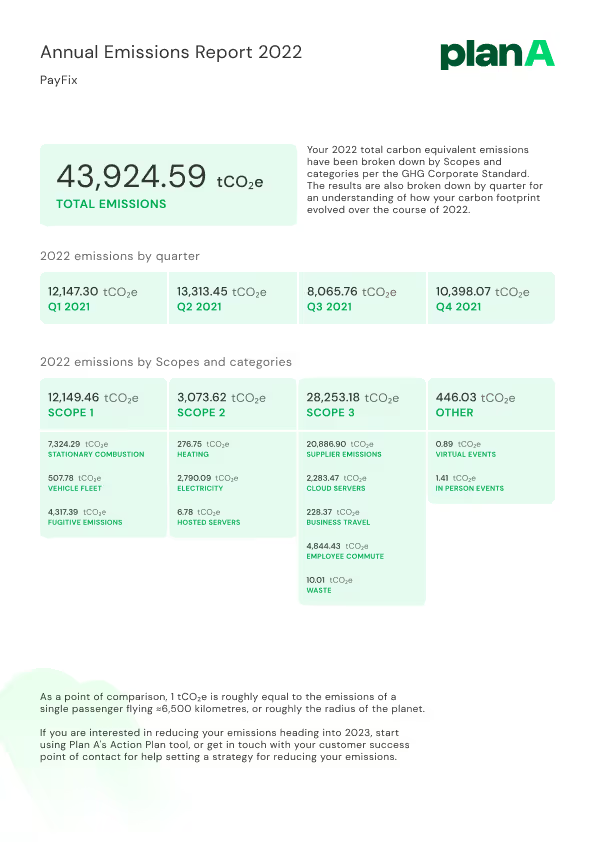Sustainability is very often approached from the target perspective. The Paris Agreement itself proved that it was easier to agree on a target than on the means of achieving it.
As companies begin their decarbonisation journey, they often encounter common challenges: data is not precise enough to show decarbonisation, actions are not impactful sufficient on a carbon level, and targets are not based on pragmatic reduction potentials. When sustainability managers hit these first roadblocks, they may realise that perfect is the enemy of good. Starting with specific categories and designing future-forward strategies that will help improve rather than lock in emissions reporting and data collection processes.
Companies are fast-moving entities. They may grow, accelerate or slow down, transform and evolve, often year-on-year. The reporting landscape is also changing, tweaking the required data points and, most importantly, requiring an action plan over the years to decarbonise the company. To match the evolving nature of the regulatory landscape, the reporting entity (your company) and the volatility of data collection processes, it is essential that the decarbonisation strategy is viewed as an iterative process rather than a declarative aspirational exercise to match the Paris Agreement target.
Accordingly, this article emphasises the importance of viewing decarbonisation as an ongoing, cyclical process that leads us toward a sustainable future.

Credit Unsplash
Decarbonisation as an iterative process
The fight against climate change is an enduring long-term effort that unfolds over time. Decarbonisation is not achieved overnight; it's a continuous journey of transformation and adaptation. What’s more, a company can roll back its efforts or loose the progress it made. Sustainability is something to uphold and upkeep rather than a project with a beginning and end. Here's why viewing it as such is essential.
The changing landscape
The landscape of decarbonisation is in constant flux. New technologies emerge, regulations evolve, and market dynamics shift. As a result, organisations must remain agile and responsive to these changes. Embracing decarbonisation as an ongoing process allows for timely adjustments to stay aligned with current best practices.
Long-term sustainability
Sustainability isn't just about reducing emissions for a year or two–it's about building a lasting foundation for future generations.
A continual commitment to decarbonisation ensures that the positive impacts on the environment and society are sustained over the long haul.
Innovation and improvement
Viewing decarbonisation as an iterative journey encourages a culture of innovation and improvement. Organisations are motivated to seek new ways to reduce emissions, optimise processes, and enhance sustainability. This mindset fosters creativity and resilience in the face of challenges. Irrupting technologies such as AI can also be integrated into your workflows and strategic approach much more quickly and responsibly penetrate your company from the sustainability space.
Stakeholder engagement
Engaging stakeholders, from employees to customers to investors, in an ongoing decarbonisation journey builds trust and commitment. People want to be a part of something meaningful and long-lasting. Sharing progress and achievements along the way keeps stakeholders invested in the mission.
A living strategy will bring more return than a static one.
The Sustainability strategy impacts and is impacted by the company's business strategy and all the factors influencing it. Conducting sustainable transformation touches all departments and activities. Reciprocally, the strategy should take into account all these inputs. This is why we consider strategy documents to be living, lean pieces.
Enables incremental change and creates achievements
Companies can foster a motivated, green-oriented workforce by building a dedicated sustainability team and engaging all employees in decarbonisation strategies. This green team enables continuous improvement, helping companies achieve their sustainability goals year after year.
Supports scalability
While pursuing net-zero or carbon-negative operations may seem daunting, companies can start small and achieve quick wins. Businesses can identify low-hanging fruit by implementing targeted emissions reduction measures and gradually decarbonising their value chains. Updating the roadmap frequently without disrupting the common understanding and workflow allows sustainability managers to make progress more independently.
Increases credibility of emissions calculations
Enhancing sustainability strategies leads to more accurate emissions calculations, instilling confidence in a company’s environmental performance and reporting. By communicating effectively about the current limitations of your report and how you plan on improving key areas, you create an ongoing trusting relationship with your stakeholders that is not based on perfection but on honesty. There will always be caveats and proxies integrated into emissions reporting, and the goal is to prioritise and zero in on the most accurate number and methodology that can be updated and improved reporting cycle after reporting cycle.
Streamline other company processes
Scaling up sustainability efforts enables companies to measure their performance using open data sets and benchmarks. This process often leads to discovering and streamlining other operational processes, ultimately improving overall business efficiency. As company priorities evolve, different areas of the sustainability manager role become more relevant than others. Sustainability strategies should account for this volatility in business orientation and goals.
Your best opportunity to take transformative action
Decarbonisation is a business opportunity. Companies can derive numerous benefits, including transformative innovation. Rethinking operations, such as reusing carbon in products, reducing raw materials, and finding alternatives to traditional consumption habits, paves the way for a successful company. A report revealed that bold climate action could yield a direct economic gain of $26 trillion through 2030 compared to business-as-usual scenarios.
A sustainable economy thrives on innovation, learning by doing, and scaling solutions. The future we’re building is one where cities are livable and productive, infrastructure is both efficient and resilient, and ecosystems are stronger than ever. Decarbonisation is an opportunity to create lasting, scalable impact.
How to implement the 5 phases of continuous improvement
So, how can you put your company’s sustainability on an iterative path? To embrace the concept of constant decarbonisation, consider implementing the following cyclical approach.
1. Reflect and learn
At the start of each cycle, reflect on the progress made in the previous period. What worked well? What challenges were encountered? What lessons were learned? Focus on why things unfolded as they did, which would help you uncover the underlying root causes. Using causal diagrams, such as Ishikawa diagrams, could help find what’s preventing your organisation from reaching its targets. This introspection phase sets the stage for informed decision-making and can be called back in subsequent steps. It is also the first step in building a viable strategy: why is the company considering taking steps towards sustainability? How can it leverage existing activities or know-how within the company? Those questions will get you going and cut time-to-implementation drastically by defining better starting points.
2. Set updatable targets
With a deeper understanding of your organisation's decarbonisation journey and its capacity to continue, set updated targets that reflect current circumstances, emerging opportunities, and regulatory changes. These targets should be ambitious yet achievable, driving the organisation towards long-term sustainability goals. Targets should also be something your data is capable of measuring. If you set a reduction goal for which you cannot verify the results (for instance, for lack of granular data), it is probably too early to set it as a goal. Consider questing for the data to measure that goal as the foundational step to implement the goal.

3. Implement emission reduction projects
Materialise your strategy by executing emission reduction projects. This could include adopting renewable energy sources, improving supply chain sustainability, streamlining your operations to run more efficiently, or encouraging sustainable behaviours among employees. This could also mean onboarding new talent to help you trim and execute your decarbonisation strategy. Even before you have complete visibility, laying down early actions creates momentum and an action-driven project management rather than bulky top-down multifaceted tactic documents that will stress the team members giving time and their managers, allowing for this resource diversion to happen.
4. Monitor and report on progress.
Continuously monitor and report progress using your carbon accounting platform. Transparency and accountability are critical drivers of successful decarbonisation. Share your small achievements with stakeholders to maintain their commitment and support. A year-on-year report using different metrics or factors is not often used when gauging success. We recommend using a platform accepting migration or calculations done off-platform. It is paramount that the sustainability manager provides regular updates to the management and the greater team. Track records are only good if they are backed.

Credit: Plan A
5. Adapt and repeat
Stay flexible and adaptable as the decarbonisation landscape evolves. As new challenges and opportunities arise, be ready to adjust strategies, adopt new technologies, and refine processes. The cycle of reflection, target setting, action, and adaptation becomes a part of your organisation's DNA.
Potential challenges in improving companies’ sustainability strategy

Credit: Getty
Data collection
Companies face the dilemma of improving data collection processes or prioritising reduction actions. Effective data collection enables informed decision-making and targeted reduction efforts, making it an integral part of a sustainable strategy. Creating a squad of people capable of retrieving data from the different company systems is essential to successfully getting started. Progressively, you can explain (and show!) how your end dashboard looks and what granularity you are trying to achieve for which action. This can link the data to the tangible action and generate significant momentum shared across teams. Tools are essential to build a defensible strategy. Collecting data costs time and effort, and using a tool will reduce time-to-report and time-to-action.
Adaptability
Adapting to long-term planning and change management can be challenging for companies. A study by McKinsey & Company found that 92% of executives believe their organisations need to improve their ability to adapt to new sustainability-related risks. Too many companies feel shy or tied to commitments they made at times when they lacked feasibility information. Instead of taking a binary approach of having or not having targets, it is often better to set adaptable long-term goals and implement transformation by touch.
As product teams might say, we try to be “firm on the vision, flexible on the details” when creating a decarbonisation strategy.
Diverse definitions of sustainability
Sustainability is defined differently across companies and industries, creating challenges in designing and implementing a one-size-fits-all solution. Tailored sustainability solutions, such as those offered by Plan A, can address these challenges by providing a customised approach to meet each company’s unique needs. Navigating the views of the CEO and those of the employee activist is part of the role of the sustainability manager. As an expert, they should be the best people to recommend specific courses of action and why, balancing pragmatic company bottom-line considerations with aspirational exemplary behaviours.
Stakeholder fatigue
Maintaining motivation to improve continuously is critical after reaping initial benefits such as an enhanced brand image, improved employer branding, reduced costs, and increased profits. According to a survey, 81% of companies find maintaining momentum for their sustainability efforts difficult. Keep projects moving and make all things achievable and well-communicated. Also, organise periodic touch points that ensure the sustainability “project” is visible more than once a month.
Sustainability teams should bring findings to the table and “give back” to their organisation by becoming relevant to the key bottom lines. From identifying resource leaks to adding value to products and brands, sustainability must become part of a company's mainstream narrative and process.
Takeaways for building a sustainability strategy
Flexibility should not come at the cost of delivering on ambitious targets. This article aims to emphasise how much quicker a company can reach ambitious targets if it focuses on the right target for its current state, can shift resources, and delivers fast on multiple projects.
Sustainability is a transversal activity that influences (and is influenced by) the core of business. Therefore, it is natural that the sustainability strategy should work in unison with the commercial strategy and the product vision. The interplay between these stakes is the challenge and the space in which large-scale core changes can happen. The best approach for your company is a strategy that provides a roadmap with solid posts and goals grounded in reality.
Finally, your strategy should be based on the same data that the rest of the business uses to inform its next steps. By putting data at the heart of your plan, identifying hotspots and acting on different company areas, other departments can engage and speak the same language as you.
To do so, tools like Plan A allow you to input business activity data to create an additional shared layer of information on the business. With these foundations, the sustainability team can build a strategy to hit the ground running and stay on the rails as the business and its environment evolve.




.jpg)

.webp)



